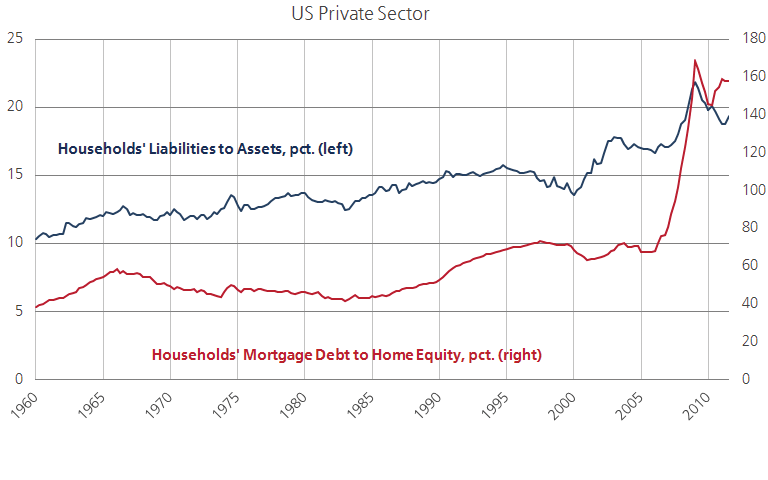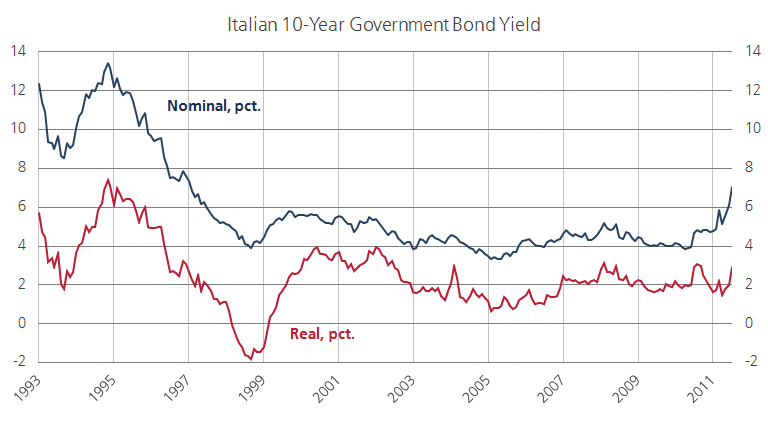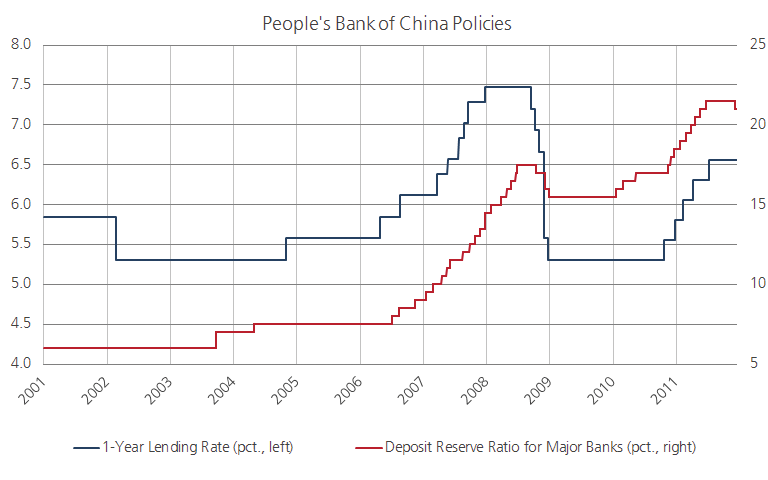The world economy eased off the accelerator in 2011 as foreign trade growth and government stimuli faded and the prospects for 2012 are for more of the same. The developed economies will struggle with weak domestic demand as austerity programmes and soft labour markets take their toll while emerging economies see foreign trade ease, meaning reliance will have to be more on domestic demand, which will see central banks swinging into action and loosening monetary policy. Overall, we look for world growth to slow further in 2012 to 3 percent.
US – the outperformer among developed economies
The Great Recession was an entirely different animal to previous recessions as the impact on the economy from the liquidation of malinvestments has been exasperated by a still ongoing private sector deleveraging process. The US economy has struggled with the ramifications of this private sector indebtedness for the better part of a decade now and while the deleveraging process is slowing down that it is still a far cry from the happy-go-lucky days of the early noughties when debt and a growing economy went hand in hand. The process continues to put a damper on private sector contribution to the current expansion and with a mostly uncooperative Congress the public sector will not receive much additional help in 2012. With these two factors combined you have a continuation of the timid expansion seen in 2011 with subsiding inflation and a softening labour market. Though the risks from the Eurozone sovereign debt crisis and a weaker Asia (China) loom so large that a recession cannot be ruled out it is not our preferred scenario; rather we look for the US to ‘muddle through’. 
Europe – on the receiving end of the perfect storm
While we expect the US to muddle through the same cannot be said about Europe where public sector austerity prevails to a degree not seen across the Atlantic. The US and Europe share many of the same problems - high unemployment, weak wage growth and an indebted private sector - but the management, or rather mismanagement, of the bloated public deficits is not one of them.
The US, as a sovereign currency issuer, does not have a problem financing itself, a position many Eurozone countries would kill for presently as they see yields shoot up to untenable levels; illustrated by Italy in the above chart, which has passed the infamous 7 percent level several times recently (though we note that real rates are not too high on a historical basis). With Germany adamant (for now) that the European Central Bank should not engage in unsterilised sovereign bond purchases this is not an option for the beleaguered Eurozone, which has instead chosen a rather painful exercise of cutting public sector costs just enough for the economy to remain in a state of prolonged recession, but not enough to deal quickly and efficiently with the real issues. The Eurozone is expected to tip into negative growth in the fourth quarter of 2011 and stay there in the first quarter of 2012 thereby confirming the recession. The UK, which is in a similar position to the US, is expected to outperform the Euro area next year though the UK has plenty of rough seas to steer clear of itself.
Asia – hurt by the slowdown in the developed world
The headwinds faced by Western economies are finding their way to Asia. Even the Chinese “growth miracle”, which has based its economy on investments and exports, has to cope with weaker trade growth as evidenced by its trade balance which is down 19 percent in the twelve months through November compared to the year before. The decline in global trade growth is bound to continue and requires China to find growth elsewhere, an undertaking we expect the Chinese are only partly able to achieve – hence our below consensus forecast for Chinese GDP of 8 percent.
China however has a weapon that most developed economies do not possess, namely rate cuts. The tightening phase, which began in 2010 as the economy regained traction and inflation pressures started to build, has been on hold at the People’s Bank of China lately. Indeed we have already witnessed the first cut in reserve ratio requirements. The tightening phase thus points to plenty of available firepower should the central bank deem it necessary to stimulate more to keep Chinese growth at a respectable level and with inflation on retreat the first hurdle is out of the way. We look for a succession of cuts to reserve ratio requirements and interest rates this year as China moves to strengthen the investment side of its economy to compensate for the weakness in foreign trade.
- English (UK)
- English (India)
- English (Canada)
- English (Australia)
- English (South Africa)
- English (Philippines)
- English (Nigeria)
- Deutsch
- Español (España)
- Español (México)
- Français
- Italiano
- Nederlands
- Português (Portugal)
- Polski
- Português (Brasil)
- Русский
- Türkçe
- العربية
- Ελληνικά
- Svenska
- Suomi
- עברית
- 日本語
- 한국어
- 简体中文
- 繁體中文
- Bahasa Indonesia
- Bahasa Melayu
- ไทย
- Tiếng Việt
- हिंदी
Q1 Macro Outlook: Navigating the Rough Seas of the Perfect Storm
Published 01/13/2012, 09:19 AM
Updated 03/19/2019, 04:00 AM
Q1 Macro Outlook: Navigating the Rough Seas of the Perfect Storm
Latest comments
Loading next article…
Install Our App
Risk Disclosure: Trading in financial instruments and/or cryptocurrencies involves high risks including the risk of losing some, or all, of your investment amount, and may not be suitable for all investors. Prices of cryptocurrencies are extremely volatile and may be affected by external factors such as financial, regulatory or political events. Trading on margin increases the financial risks.
Before deciding to trade in financial instrument or cryptocurrencies you should be fully informed of the risks and costs associated with trading the financial markets, carefully consider your investment objectives, level of experience, and risk appetite, and seek professional advice where needed.
Fusion Media would like to remind you that the data contained in this website is not necessarily real-time nor accurate. The data and prices on the website are not necessarily provided by any market or exchange, but may be provided by market makers, and so prices may not be accurate and may differ from the actual price at any given market, meaning prices are indicative and not appropriate for trading purposes. Fusion Media and any provider of the data contained in this website will not accept liability for any loss or damage as a result of your trading, or your reliance on the information contained within this website.
It is prohibited to use, store, reproduce, display, modify, transmit or distribute the data contained in this website without the explicit prior written permission of Fusion Media and/or the data provider. All intellectual property rights are reserved by the providers and/or the exchange providing the data contained in this website.
Fusion Media may be compensated by the advertisers that appear on the website, based on your interaction with the advertisements or advertisers.
Before deciding to trade in financial instrument or cryptocurrencies you should be fully informed of the risks and costs associated with trading the financial markets, carefully consider your investment objectives, level of experience, and risk appetite, and seek professional advice where needed.
Fusion Media would like to remind you that the data contained in this website is not necessarily real-time nor accurate. The data and prices on the website are not necessarily provided by any market or exchange, but may be provided by market makers, and so prices may not be accurate and may differ from the actual price at any given market, meaning prices are indicative and not appropriate for trading purposes. Fusion Media and any provider of the data contained in this website will not accept liability for any loss or damage as a result of your trading, or your reliance on the information contained within this website.
It is prohibited to use, store, reproduce, display, modify, transmit or distribute the data contained in this website without the explicit prior written permission of Fusion Media and/or the data provider. All intellectual property rights are reserved by the providers and/or the exchange providing the data contained in this website.
Fusion Media may be compensated by the advertisers that appear on the website, based on your interaction with the advertisements or advertisers.
© 2007-2024 - Fusion Media Limited. All Rights Reserved.
